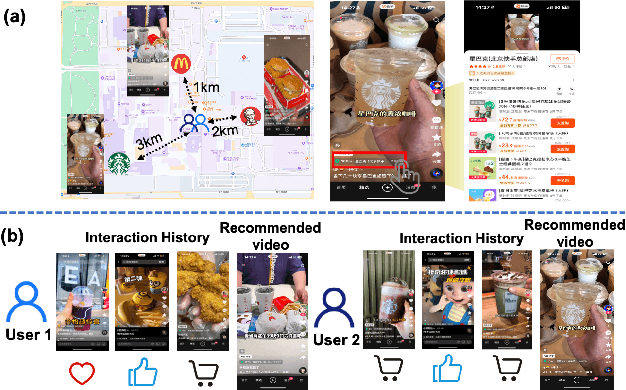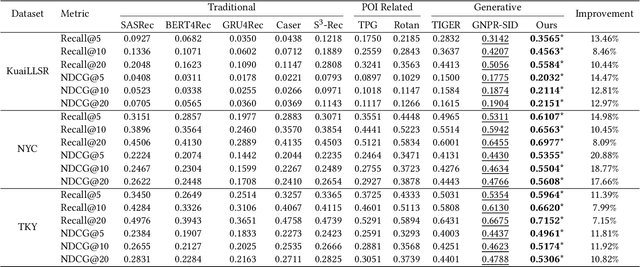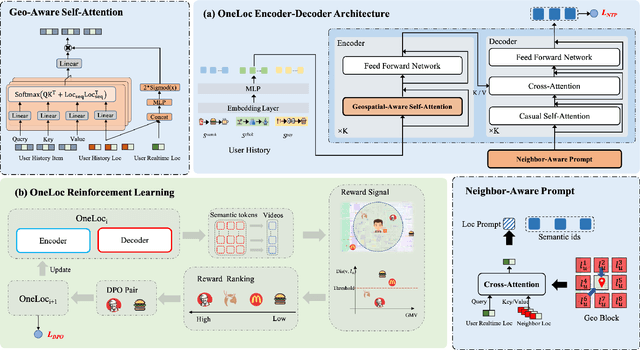Kun Gai
Sample By Step, Optimize By Chunk: Chunk-Level GRPO For Text-to-Image Generation
Oct 24, 2025Abstract:Group Relative Policy Optimization (GRPO) has shown strong potential for flow-matching-based text-to-image (T2I) generation, but it faces two key limitations: inaccurate advantage attribution, and the neglect of temporal dynamics of generation. In this work, we argue that shifting the optimization paradigm from the step level to the chunk level can effectively alleviate these issues. Building on this idea, we propose Chunk-GRPO, the first chunk-level GRPO-based approach for T2I generation. The insight is to group consecutive steps into coherent 'chunk's that capture the intrinsic temporal dynamics of flow matching, and to optimize policies at the chunk level. In addition, we introduce an optional weighted sampling strategy to further enhance performance. Extensive experiments show that ChunkGRPO achieves superior results in both preference alignment and image quality, highlighting the promise of chunk-level optimization for GRPO-based methods.
Mitigating the Noise Shift for Denoising Generative Models via Noise Awareness Guidance
Oct 14, 2025Abstract:Existing denoising generative models rely on solving discretized reverse-time SDEs or ODEs. In this paper, we identify a long-overlooked yet pervasive issue in this family of models: a misalignment between the pre-defined noise level and the actual noise level encoded in intermediate states during sampling. We refer to this misalignment as noise shift. Through empirical analysis, we demonstrate that noise shift is widespread in modern diffusion models and exhibits a systematic bias, leading to sub-optimal generation due to both out-of-distribution generalization and inaccurate denoising updates. To address this problem, we propose Noise Awareness Guidance (NAG), a simple yet effective correction method that explicitly steers sampling trajectories to remain consistent with the pre-defined noise schedule. We further introduce a classifier-free variant of NAG, which jointly trains a noise-conditional and a noise-unconditional model via noise-condition dropout, thereby eliminating the need for external classifiers. Extensive experiments, including ImageNet generation and various supervised fine-tuning tasks, show that NAG consistently mitigates noise shift and substantially improves the generation quality of mainstream diffusion models.
Attention as a Compass: Efficient Exploration for Process-Supervised RL in Reasoning Models
Sep 30, 2025Abstract:Reinforcement Learning (RL) has shown remarkable success in enhancing the reasoning capabilities of Large Language Models (LLMs). Process-Supervised RL (PSRL) has emerged as a more effective paradigm compared to outcome-based RL. However, existing PSRL approaches suffer from limited exploration efficiency, both in terms of branching positions and sampling. In this paper, we introduce a novel PSRL framework (AttnRL), which enables efficient exploration for reasoning models. Motivated by preliminary observations that steps exhibiting high attention scores correlate with reasoning behaviors, we propose to branch from positions with high values. Furthermore, we develop an adaptive sampling strategy that accounts for problem difficulty and historical batch size, ensuring that the whole training batch maintains non-zero advantage values. To further improve sampling efficiency, we design a one-step off-policy training pipeline for PSRL. Extensive experiments on multiple challenging mathematical reasoning benchmarks demonstrate that our method consistently outperforms prior approaches in terms of performance and sampling and training efficiency.
GoalRank: Group-Relative Optimization for a Large Ranking Model
Sep 26, 2025Abstract:Mainstream ranking approaches typically follow a Generator-Evaluator two-stage paradigm, where a generator produces candidate lists and an evaluator selects the best one. Recent work has attempted to enhance performance by expanding the number of candidate lists, for example, through multi-generator settings. However, ranking involves selecting a recommendation list from a combinatorially large space. Simply enlarging the candidate set remains ineffective, and performance gains quickly saturate. At the same time, recent advances in large recommendation models have shown that end-to-end one-stage models can achieve promising performance with the expectation of scaling laws. Motivated by this, we revisit ranking from a generator-only one-stage perspective. We theoretically prove that, for any (finite Multi-)Generator-Evaluator model, there always exists a generator-only model that achieves strictly smaller approximation error to the optimal ranking policy, while also enjoying scaling laws as its size increases. Building on this result, we derive an evidence upper bound of the one-stage optimization objective, from which we find that one can leverage a reward model trained on real user feedback to construct a reference policy in a group-relative manner. This reference policy serves as a practical surrogate of the optimal policy, enabling effective training of a large generator-only ranker. Based on these insights, we propose GoalRank, a generator-only ranking framework. Extensive offline experiments on public benchmarks and large-scale online A/B tests demonstrate that GoalRank consistently outperforms state-of-the-art methods.
OneRec-V2 Technical Report
Aug 28, 2025Abstract:Recent breakthroughs in generative AI have transformed recommender systems through end-to-end generation. OneRec reformulates recommendation as an autoregressive generation task, achieving high Model FLOPs Utilization. While OneRec-V1 has shown significant empirical success in real-world deployment, two critical challenges hinder its scalability and performance: (1) inefficient computational allocation where 97.66% of resources are consumed by sequence encoding rather than generation, and (2) limitations in reinforcement learning relying solely on reward models. To address these challenges, we propose OneRec-V2, featuring: (1) Lazy Decoder-Only Architecture: Eliminates encoder bottlenecks, reducing total computation by 94% and training resources by 90%, enabling successful scaling to 8B parameters. (2) Preference Alignment with Real-World User Interactions: Incorporates Duration-Aware Reward Shaping and Adaptive Ratio Clipping to better align with user preferences using real-world feedback. Extensive A/B tests on Kuaishou demonstrate OneRec-V2's effectiveness, improving App Stay Time by 0.467%/0.741% while balancing multi-objective recommendations. This work advances generative recommendation scalability and alignment with real-world feedback, representing a step forward in the development of end-to-end recommender systems.
OneLoc: Geo-Aware Generative Recommender Systems for Local Life Service
Aug 20, 2025



Abstract:Local life service is a vital scenario in Kuaishou App, where video recommendation is intrinsically linked with store's location information. Thus, recommendation in our scenario is challenging because we should take into account user's interest and real-time location at the same time. In the face of such complex scenarios, end-to-end generative recommendation has emerged as a new paradigm, such as OneRec in the short video scenario, OneSug in the search scenario, and EGA in the advertising scenario. However, in local life service, an end-to-end generative recommendation model has not yet been developed as there are some key challenges to be solved. The first challenge is how to make full use of geographic information. The second challenge is how to balance multiple objectives, including user interests, the distance between user and stores, and some other business objectives. To address the challenges, we propose OneLoc. Specifically, we leverage geographic information from different perspectives: (1) geo-aware semantic ID incorporates both video and geographic information for tokenization, (2) geo-aware self-attention in the encoder leverages both video location similarity and user's real-time location, and (3) neighbor-aware prompt captures rich context information surrounding users for generation. To balance multiple objectives, we use reinforcement learning and propose two reward functions, i.e., geographic reward and GMV reward. With the above design, OneLoc achieves outstanding offline and online performance. In fact, OneLoc has been deployed in local life service of Kuaishou App. It serves 400 million active users daily, achieving 21.016% and 17.891% improvements in terms of gross merchandise value (GMV) and orders numbers.
MISS: Multi-Modal Tree Indexing and Searching with Lifelong Sequential Behavior for Retrieval Recommendation
Aug 20, 2025



Abstract:Large-scale industrial recommendation systems typically employ a two-stage paradigm of retrieval and ranking to handle huge amounts of information. Recent research focuses on improving the performance of retrieval model. A promising way is to introduce extensive information about users and items. On one hand, lifelong sequential behavior is valuable. Existing lifelong behavior modeling methods in ranking stage focus on the interaction of lifelong behavior and candidate items from retrieval stage. In retrieval stage, it is difficult to utilize lifelong behavior because of a large corpus of candidate items. On the other hand, existing retrieval methods mostly relay on interaction information, potentially disregarding valuable multi-modal information. To solve these problems, we represent the pioneering exploration of leveraging multi-modal information and lifelong sequence model within the advanced tree-based retrieval model. We propose Multi-modal Indexing and Searching with lifelong Sequence (MISS), which contains a multi-modal index tree and a multi-modal lifelong sequence modeling module. Specifically, for better index structure, we propose multi-modal index tree, which is built using the multi-modal embedding to precisely represent item similarity. To precisely capture diverse user interests in user lifelong sequence, we propose collaborative general search unit (Co-GSU) and multi-modal general search unit (MM-GSU) for multi-perspective interests searching.
Klear-Reasoner: Advancing Reasoning Capability via Gradient-Preserving Clipping Policy Optimization
Aug 12, 2025



Abstract:We present Klear-Reasoner, a model with long reasoning capabilities that demonstrates careful deliberation during problem solving, achieving outstanding performance across multiple benchmarks. Although there are already many excellent works related to inference models in the current community, there are still many problems with reproducing high-performance inference models due to incomplete disclosure of training details. This report provides an in-depth analysis of the reasoning model, covering the entire post-training workflow from data preparation and long Chain-of-Thought supervised fine-tuning (long CoT SFT) to reinforcement learning (RL), along with detailed ablation studies for each experimental component. For SFT data, our experiments show that a small number of high-quality data sources are more effective than a large number of diverse data sources, and that difficult samples can achieve better results without accuracy filtering. In addition, we investigate two key issues with current clipping mechanisms in RL: Clipping suppresses critical exploration signals and ignores suboptimal trajectories. To address these challenges, we propose Gradient-Preserving clipping Policy Optimization (GPPO) that gently backpropagates gradients from clipped tokens. GPPO not only enhances the model's exploration capacity but also improves its efficiency in learning from negative samples. Klear-Reasoner exhibits exceptional reasoning abilities in mathematics and programming, scoring 90.5% on AIME 2024, 83.2% on AIME 2025, 66.0% on LiveCodeBench V5 and 58.1% on LiveCodeBench V6.
Score Augmentation for Diffusion Models
Aug 11, 2025Abstract:Diffusion models have achieved remarkable success in generative modeling. However, this study confirms the existence of overfitting in diffusion model training, particularly in data-limited regimes. To address this challenge, we propose Score Augmentation (ScoreAug), a novel data augmentation framework specifically designed for diffusion models. Unlike conventional augmentation approaches that operate on clean data, ScoreAug applies transformations to noisy data, aligning with the inherent denoising mechanism of diffusion. Crucially, ScoreAug further requires the denoiser to predict the augmentation of the original target. This design establishes an equivariant learning objective, enabling the denoiser to learn scores across varied denoising spaces, thereby realizing what we term score augmentation. We also theoretically analyze the relationship between scores in different spaces under general transformations. In experiments, we extensively validate ScoreAug on multiple benchmarks including CIFAR-10, FFHQ, AFHQv2, and ImageNet, with results demonstrating significant performance improvements over baselines. Notably, ScoreAug effectively mitigates overfitting across diverse scenarios, such as varying data scales and model capacities, while exhibiting stable convergence properties. Another advantage of ScoreAug over standard data augmentation lies in its ability to circumvent data leakage issues under certain conditions. Furthermore, we show that ScoreAug can be synergistically combined with traditional data augmentation techniques to achieve additional performance gains.
Selection and Exploitation of High-Quality Knowledge from Large Language Models for Recommendation
Aug 10, 2025Abstract:In recent years, there has been growing interest in leveraging the impressive generalization capabilities and reasoning ability of large language models (LLMs) to improve the performance of recommenders. With this operation, recommenders can access and learn the additional world knowledge and reasoning information via LLMs. However, in general, for different users and items, the world knowledge derived from LLMs suffers from issues of hallucination, content redundant, and information homogenization. Directly feeding the generated response embeddings into the recommendation model can lead to unavoidable performance deterioration. To address these challenges, we propose a Knowledge Selection \& Exploitation Recommendation (KSER) framework, which effectively select and extracts the high-quality knowledge from LLMs. The framework consists of two key components: a knowledge filtering module and a embedding spaces alignment module. In the knowledge filtering module, a Embedding Selection Filter Network (ESFNet) is designed to assign adaptive weights to different knowledge chunks in different knowledge fields. In the space alignment module, an attention-based architecture is proposed to align the semantic embeddings from LLMs with the feature space used to train the recommendation models. In addition, two training strategies--\textbf{all-parameters training} and \textbf{extractor-only training}--are proposed to flexibly adapt to different downstream tasks and application scenarios, where the extractor-only training strategy offers a novel perspective on knowledge-augmented recommendation. Experimental results validate the necessity and effectiveness of both the knowledge filtering and alignment modules, and further demonstrate the efficiency and effectiveness of the extractor-only training strategy.
 Add to Chrome
Add to Chrome Add to Firefox
Add to Firefox Add to Edge
Add to Edge